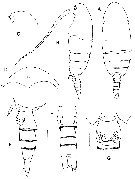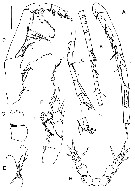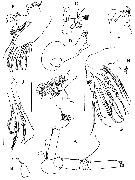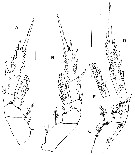|
|
 |
Fiche d'espèce de Copépode |
|
|
Calanoida ( Ordre ) |
|
|
|
Clausocalanoidea ( Superfamille ) |
|
|
|
Diaixidae ( Famille ) |
|
|
|
Byrathis ( Genre ) |
|
|
| |
Byrathis divae Markhaseva & Renz, 2011 (F) | |
| | | | | | | Ref.: | | | Markheseva & Renz, 2011 (p., figs.F) |  issued from : E.L. Markhaseva & J. Renz in Zootaxa, 2011, 2889. [p.51, Fig.1]. Female (17°06.2'S, 04°41.7'E): A-B, habitus (dorsal and lateral, respectively); C-D; rostrum (lateral and anteroventral, respectively); E, urosome (dorsal view); F, posterior prosome and urosome (lateral view); G, posterior corner of prosome and genital double-somite (ventral view). Scale bars: 0.5 mm (A-B); 0.1 mm (C-G). Nota : Prosome 2.8-3.3 times as long as urosome. Rostrum absent. Cephalosome and pedigerous somite 1 and pedigerous somites 4 and 5 separate. A1 24-segmented, extending to distal margin of urosomal segments 3-4. Caudal ramus with 1 dorsal, 1 ventral, and 4 terminal setae.
|
 issued from : E.L. Markhaseva & J. Renz in Zootaxa, 2011, 2889. [p.52, Fig.2]. Female: A, A1 segments 1-8 (ancestral: I-XI); B, A1 segments 9-18 (ancestral: XII-XXI); C, A1 segments 19-24 (ancestral: XXII-XXVIII); D, Mxp; E, Mxp (distal part of coxal endite of syncoxa)); F, P1 (posterior surface); G, P1 (coxa and basis; anterior surface); H, P5. Arrows mark enlarged distal part of segment XXVII-XXVIII and scar for aesthetasc. Scale bars: 0.1 mm. Holotype: A-D, F, H; paratype: E. Nota : Mxp : syncoxa with 1 seta on proximal praecoxal lobe, 2 setae on middle praecoxal endite and 2 sclerotized setae and 1 poorly developed brush-like seta on distal praecoxal endite ; coxal lobe with 3 setae and small attenuation. Basis with 3 setae and row of ninute hairs. Endopod 6-segmented with 2, 4, 4, 3, 3+1, and 4 setae. P5 3-segmented, coxa and basis with distolateral patch of spinules, exopod ornamented with rare surface spinules, 3 distal spines and terminal attenuation.
|
 issued from : E.L. Markhaseva & J. Renz in Zootaxa, 2011, 2889. [p.53, Fig.3]. Female: A, A2 (basis, endo- and exopod); B, coxa of A2; C, Md (mandibular palp); D, Md (mandibular gnathobase); E, Md (cutting edge); F, Mx1; G, Mx2 (sensory setae of endopod are not figured); H, Mx2 (praecoxal endite)I, Mx2 ( (endopod with sensory setae); J, Mx2 distal basal endite (previously considered as distal coxal endite) and enditic-like lobe of proximal endopodal segment (previously considered as proximal basal endite). Scale bars: 0.1 mm. Holotype (A, C-D, F-G, I); paratype (B, E, H, J). Nota : Prosome 2.8-3.3 times as long as urosome. Rostrum absent. Cephalosome and pedigerous somite 1 and pedigerous somites 4 and 5 separate. A1 24-segmented, extending to distal margin of urosomal segments 3-4. Caudal ramus with 1 dorsal, 1 ventral, and 2 terminal setae.
Nota : Md : gnathobase with crest ; cutting edge with 5 large and 3 small teeth near thick dorsal seta. Basis with 3 setae. Exopod 5-segmented with 1, 1, 1, 1, and 2 setae. Endopod 2-segmented , segment 1 with 2 setae, segment 2 with 8 long and 1 short setae. Mx1 : praecoxal arthrite with 9 marginal setae (4 posterior and 1 anterior) ; coxal endite with 2 setae ; coxal epipodite with 6 long and 3 short setae ; proximal basal endite with 3 setae, distal basal endite with 2 setae ; endopod with 7 setae ; exopod with 6-7 setae. Mx2 : praecoxal endite (previously considered as proximal praecoxal endite) with 4 setae and a short attenuation ; coxal endite (previously considered as distal praecoxal endite) with 3 setae ; basal endites (previously considerd as coxal endites) with 3 setae each, 1 seta of distal basal endite thicker, spine-like ; enditic-like lobe of proximal endopodal segment (previously considered as proximal basal endite) with 4 setae, 1 is thicker and 1 is partly sensory ; endopod with 3 worm-like and 5 poorly developed brush-like sensory setae .
|
 issued from : E.L. Markhaseva & J. Renz in Zootaxa, 2011, 2889. [p.554, Fig.4]. Female: A, P2; B, P3; C, P4 (coxa, basis, endopodal and exopodal segments 1; D, P4 (exopodal segments 2-3); E, P4 (endopodal segments 2-3). Scale bars: 0.1 mm.
| | | | | NZ: | 3 | | |
|
Carte de distribution de Byrathis divae par zones géographiques
|
| | | | | | | Loc: | | | S Atlant. (17°6'S, 4°41.7'E; 41°S, 5°-9°E; 58°-65°S, 24°-51°W) | | | | N: | 1 | | | | Lg.: | | | (1088) F: 2,1-2,47; {F: 2,10-2,47} | | | | Rem.: | hyperbenthic, abyssal (3000 -5400 m).
After Markhaseva & Renz (2011, p.55), some specimens from the Antactic samples differ from those of the type series in setation details of A1 and oral parts. | | | Dernière mise à jour : 30/12/2014 | |
|
|
 Toute utilisation de ce site pour une publication sera mentionnée avec la référence suivante : Toute utilisation de ce site pour une publication sera mentionnée avec la référence suivante :
Razouls C., Desreumaux N., Kouwenberg J. et de Bovée F., 2005-2024. - Biodiversité des Copépodes planctoniques marins (morphologie, répartition géographique et données biologiques). Sorbonne Université, CNRS. Disponible sur http://copepodes.obs-banyuls.fr [Accédé le 16 avril 2024] © copyright 2005-2024 Sorbonne Université, CNRS
|
|
 |
 |







